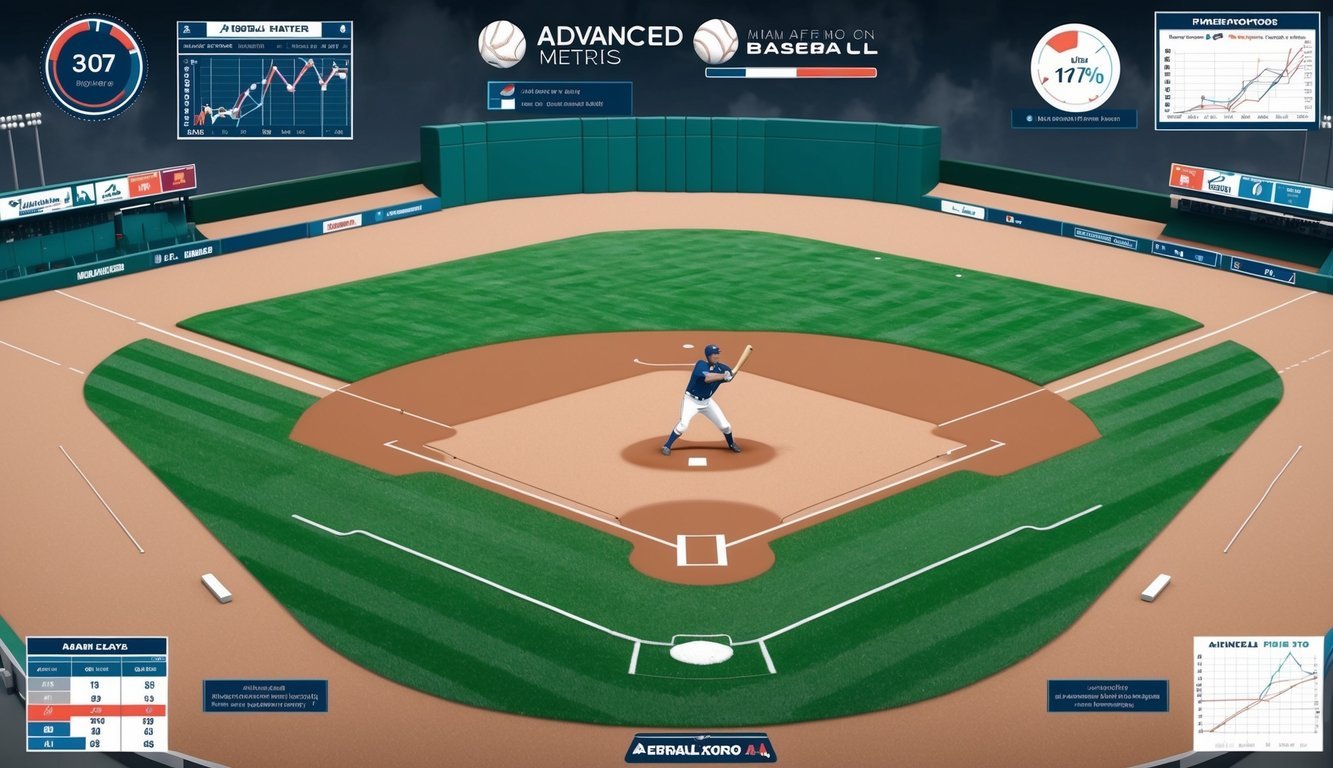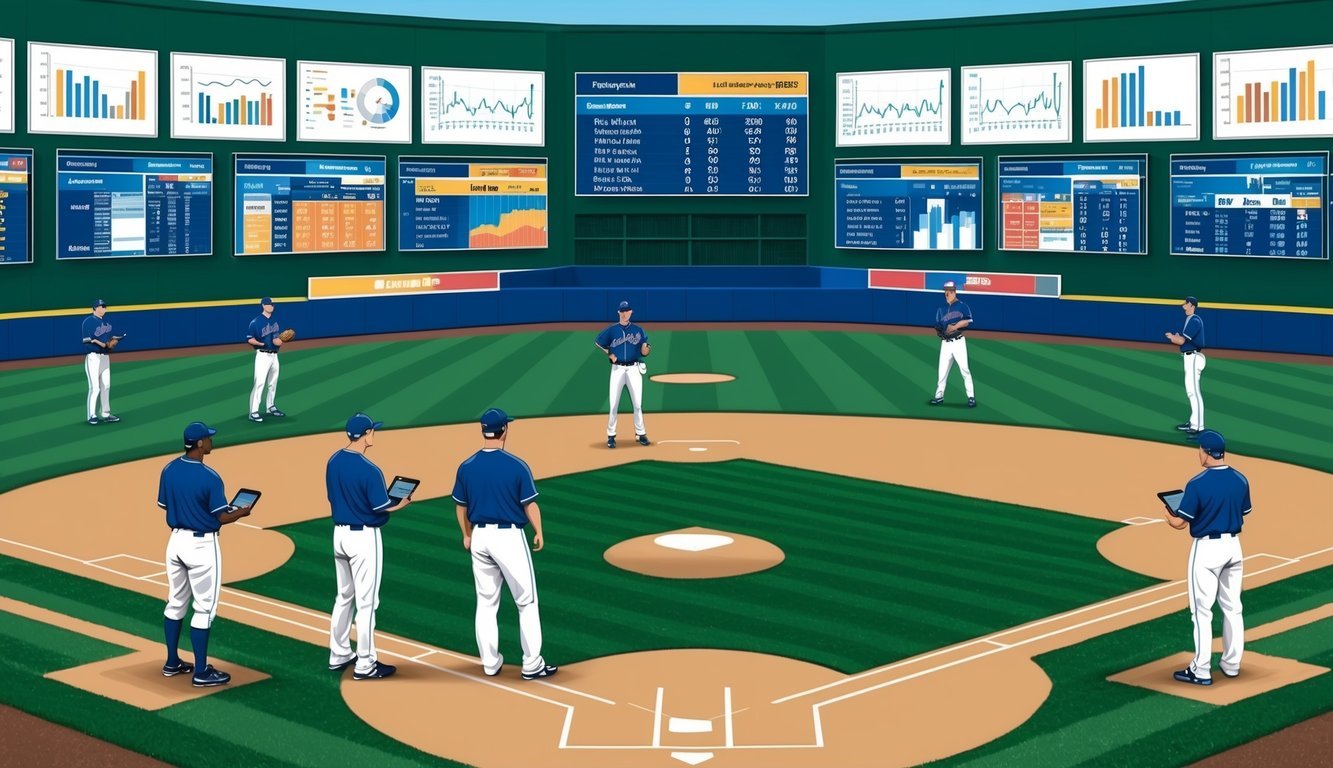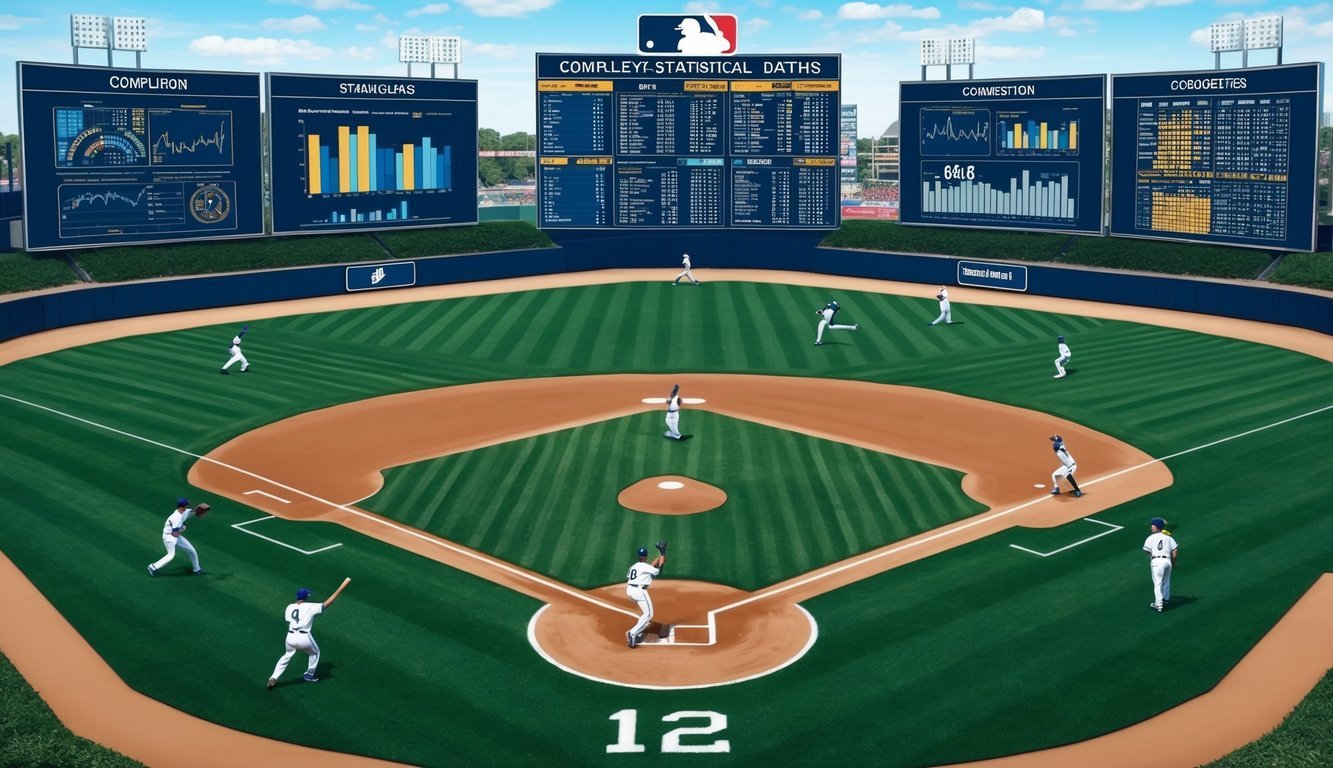Baseball has undergone a statistical revolution in recent decades.
Advanced metrics and analytics have transformed how teams evaluate players, make strategic decisions, and build rosters.
These data-driven approaches have given clubs new insights into player performance and game strategy, altering the competitive landscape of Major League Baseball.
The rise of sabermetrics, pioneered by analysts like Bill James in the 1970s and 80s, laid the groundwork for today’s analytics movement.
Teams now employ sophisticated statistical models to assess everything from a batter’s true offensive value to a pitcher’s effectiveness in different situations.
Metrics like on-base plus slugging (OPS), wins above replacement (WAR), and fielding independent pitching (FIP) have become common parlance among fans and integral tools for front offices.
This analytical approach has reshaped player development, in-game tactics, and even the way fans engage with the sport.
Teams use technology like Statcast to measure previously unquantifiable aspects of the game.
The Oakland Athletics’ “Moneyball” strategy famously demonstrated how smaller-market clubs could compete by exploiting inefficiencies revealed through data analysis.
As analytics continue to evolve, they promise to unlock new dimensions of baseball strategy and player evaluation.
The Evolution of Baseball Analytics
Baseball’s analytical revolution transformed how the game is understood and played.
Data-driven approaches reshaped player evaluation, strategy, and team management across Major League Baseball.
From Box Scores to Sabermetrics
In baseball’s early days, basic box scores provided limited statistical insights.
Batting average, home runs, and earned run average (ERA) were the primary metrics fans and teams relied on.
As the sport grew more complex, so did analysis methods.
The 1950s and 60s saw pioneers like Branch Rickey experimenting with new ways to measure player performance.
Rickey, known for breaking baseball’s color barrier, also developed innovative stats.
In the 1970s, baseball researcher Bill James coined the term “sabermetrics.” This marked the birth of a more scientific approach to baseball analysis.
James published groundbreaking work in his Baseball Abstract series, introducing new metrics and challenging conventional wisdom.
Pioneers of Modern Baseball Statistics
Pete Palmer and F.C. Lane made significant contributions to baseball statistics in the early-to-mid 20th century.
Their work laid the foundation for future advancements.
The 2003 book Moneyball, by Michael Lewis, popularized the use of analytics in baseball.
It chronicled how the Oakland Athletics used data to build competitive teams on a budget.
The success of the A’s inspired other teams to embrace analytics.
The Chicago Cubs and Detroit Tigers were among the early adopters, integrating data into their decision-making processes.
Today, all MLB teams employ analytics departments.
Advanced metrics like WAR (Wins Above Replacement) and exit velocity are now commonplace in broadcasts and discussions among fans.
Core Concepts in Baseball Metrics
Advanced baseball metrics provide deeper insights into player performance and team strategy.
These statistics go beyond traditional measures to offer a more comprehensive evaluation of a player’s contributions on the field.
Understanding On-Base Percentage (OBP)
On-Base Percentage (OBP) measures how often a batter reaches base.
It includes hits, walks, and hit-by-pitches divided by total plate appearances.
OBP is crucial because it reflects a player’s ability to avoid outs and create scoring opportunities.
A player with a high OBP consistently gets on base, pressuring the defense and setting up runs.
League average OBP typically hovers around .320, with elite players reaching .400 or higher.
OBP is often considered more valuable than batting average (BA) as it accounts for walks, which contribute to offensive production.
The Significance of Slugging Percentage (SLG)
Slugging Percentage (SLG) quantifies a batter’s power.
It’s calculated by dividing total bases by at-bats.
SLG gives more weight to extra-base hits, providing a clearer picture of a player’s ability to drive in runs.
A high SLG indicates a batter who frequently hits for extra bases.
League average SLG is usually around .400, with top sluggers exceeding .500.
SLG is often combined with OBP to create OPS (On-base Plus Slugging), a comprehensive offensive metric.
OPS balances a player’s ability to get on base with their power production.
Defining Wins Above Replacement (WAR)
Wins Above Replacement (WAR) attempts to summarize a player’s total contributions to their team.
It estimates how many more wins a player provides compared to a “replacement-level” player at the same position.
WAR incorporates offensive and defensive metrics, as well as positional adjustments.
A higher WAR indicates a more valuable player.
An average full-time player typically has a WAR of 2.0 to 2.5 per season.
WAR allows for comparisons across different positions and eras.
It’s particularly useful for evaluating trades and free agent signings, helping teams assess a player’s overall value to their roster.
Advanced Metrics and Player Analysis

Advanced metrics have revolutionized how baseball teams evaluate players and make strategic decisions.
These sophisticated tools provide deeper insights into player performance across various aspects of the game.
Assessing Player Performance with WAR
WAR (Wins Above Replacement) has become a cornerstone metric in player evaluation.
It measures a player’s total contribution to their team compared to a replacement-level player.
WAR combines offensive and defensive metrics into a single value.
A player with a WAR of 2.0 is considered average, while 5.0+ is All-Star level.
For example, Mike Trout’s career WAR of 82.4 through 2023 highlights his exceptional value.
WAR allows teams to compare players across different positions and eras.
It’s particularly useful in free agency and trade discussions, helping teams gauge a player’s overall impact.
Measuring Offensive Impact: wOBA & wRC+
wOBA (Weighted On-Base Average) and wRC+ (Weighted Runs Created Plus) offer nuanced views of a player’s offensive contributions.
wOBA assigns different weights to various offensive events based on their run value.
It provides a more accurate picture of offensive production than traditional stats like batting average.
wRC+ builds on wOBA by adjusting for park factors and league averages.
A wRC+ of 100 is league average, with each point above or below representing a percentage difference from average.
These metrics help teams identify undervalued offensive talent and make informed decisions about lineup construction and player acquisition.
Fielding Metrics: Insight into Defense
Advanced fielding metrics have transformed how teams evaluate defensive performance.
Defensive Runs Saved (DRS) and Ultimate Zone Rating (UZR) measure a player’s defensive value in runs above or below average.
These metrics consider factors like range, arm strength, and fielding efficiency.
For instance, Andrelton Simmons’ career 197 DRS at shortstop demonstrates his exceptional defensive skills.
Statcast data now provides even more detailed defensive insights, tracking metrics like Outs Above Average (OAA) based on the difficulty of plays made.
Teams use these advanced fielding metrics to optimize defensive positioning, make personnel decisions, and identify players whose defensive contributions might be undervalued by traditional statistics.
Implications of Advanced Metrics in Baseball Operations

Advanced metrics have revolutionized how baseball teams operate, influencing decision-making processes and player valuations.
These data-driven approaches have permeated front offices and contract negotiations, reshaping the landscape of America’s pastime.
Analytics-Driven Decision Making in Front Offices
MLB front offices now rely heavily on advanced metrics to guide their strategies.
Teams employ data analysts and statisticians to crunch numbers and provide insights on player performance, potential, and team composition.
This analytical approach has transformed scouting departments.
Traditional eye-test evaluations are now complemented by complex statistical models that assess a player’s true value.
Websites like FanGraphs and Baseball Prospectus have become essential resources for front office personnel.
These platforms offer in-depth statistical analysis and projections that inform roster construction and player acquisition decisions.
Some teams have gained competitive advantages by developing proprietary metrics and algorithms.
The Houston Astros, for example, built a World Series-winning team largely through data-driven strategies.
Contract Negotiations and Player Value
Advanced metrics have significantly impacted how players are valued in contract negotiations.
Traditional statistics like batting average and RBIs have taken a backseat to more comprehensive measures of player worth.
Wins Above Replacement (WAR) has become a key metric in determining a player’s value.
This catch-all statistic attempts to quantify a player’s total contributions to their team.
Front offices use predictive models to forecast future performance, influencing contract length and value.
This approach helps teams avoid overpaying for players likely to decline.
Advanced metrics have also highlighted previously undervalued skills, such as on-base percentage and defensive positioning.
This has led to increased compensation for players excelling in these areas.
Some players and agents have embraced sabermetrics, using advanced stats to bolster their negotiating positions.
Others have had to adapt their playing styles to align with what teams now value most.
The Future of Metrics in Baseball

Advanced metrics continue to reshape baseball.
New technologies and analytical approaches promise to further revolutionize how the game is played, coached, and understood.
Technological Innovations and Data Collection
Statcast has transformed data collection in Major League Baseball since 2015.
This system tracks player and ball movements with incredible precision.
It measures metrics like exit velocity, launch angle, and spin rate.
The future may bring even more sophisticated tracking.
Wearable sensors could provide real-time biometric data on players.
This could help teams optimize performance and prevent injuries.
AI and machine learning will likely play a bigger role in analyzing the vast amounts of data collected.
These tools could uncover new insights and patterns that humans might miss.
Virtual and augmented reality may also enhance player development and fan experiences.
Imagine seeing a batter’s view of a 100 mph fastball or exploring a player’s stats just by pointing your phone at them.
Transforming the Role of Coaching and Strategy
Advanced metrics are changing how coaches approach the game.
In the future, we may see more data-driven decision making on the field.
Coaches might use real-time analytics to make pitching changes or adjust defensive positioning.
The traditional “gut feeling” could be replaced by algorithms suggesting optimal strategies.
Player development could become more personalized.
Coaches might use metrics to create tailored training programs for each player.
This could help teams like the Baltimore Orioles or Boston Red Sox maximize their talent.
Strategy could evolve too.
Teams might place less emphasis on stolen bases as metrics show their limited value.
Park factors could influence roster construction more than ever.
The World Series might be won by the team that best leverages these new metrics and technologies.
Baseball’s future promises to be a fascinating blend of tradition and innovation.
Teams that embrace advanced analytics can identify undervalued players and make strategic decisions that could shift the balance of power in the league.
This shift is particularly evident in the evolution of power hitters, as their performance can now be measured and optimized with unprecedented precision.
As clubs invest in technology and data analysis, the game will continue to evolve, creating a dynamic landscape where traditional scouting methods must adapt to stay relevant.
